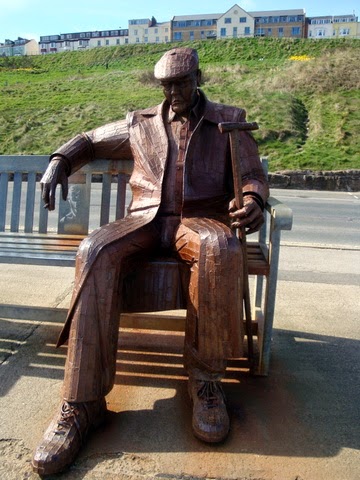Many sculptures can be seen around the country and many places are enhancing their neighbourhoods with specially commissioned sculptures. This blog depicts some which have a story to tell.
Freddy Gilroy
The huge sculpture of Freddy Gilroy has been a prominent feature of the
The huge sculpture of Freddy Gilroy has been a prominent feature of the
north side promenade at Scarborough in North Yorkshire since 2011.
discoveryorkshire.com tells us :
'Freddie Gilroy and the Belsen Stragglers' is a giant steel structure made by Ray Lonsdale, an artist, fabricator and sculptor and is now on permanent display, thanks to the generosity of a local Scarborough resident.The sculpture is based on a retired miner Ray became friends with who turned out to also be one of the first soldiers to relieve the Bergen-Belsen concentration camp at the end of World War II.
This piece of art is not just about Freddie Gilroy but represents all the normal people that were pulled out of an ordinary life and forced into a very extraordinary and dangerous one during the World Wars.
Ray Lonsdale, sculptor from County Durham said:
"Scarborough is a unique town and I am pleased that my 'Freddie Gilroy and the Belsen Stragglers' will be on show there for residents and visitors alike to look at and enjoy. This piece is almost a war memorial as it depicts the lives of all those who suffered during the World Wars".
"I hope that people get enjoyment from my sculptures but also reflect on the sensitivity and emotion which I have tried to convey through my work."
The sculpture is located near to the Oasis Cafe on Scarborough's North Bay.

The Scarborough Belles
Scarborough and District Civic Society commissioned two sculptures as a pair to celebrate Scarborough as the UK's first sea-bathing resort from the 17th century through to its regeneration in the 21st century.

The Bathing Belle in Westborough (2008)
The Diving Belle on St Vincent's Pier (2007)
The Angel of the North
The Angel of the North sculpture was erected in 1998
alongside the A167 road overlooking the A1 near Gateshead to commemorate the
millennium. This iconic modern art piece
was sculpted by Antony Gormley using 200 tonnes of steel at a cost of some
£800,000. At 65ft it is as high as four double deck buses and has a wingspan of
175ft.
Arria
Arria, the so called Angel of the Nauld as a tongue in cheek reference to the Angel of the North, can be seen overlooking the north bound carriageway 0f the M80 north of Auchenkilns. This steel sculpture was created by artist Andy Scott and has been galvanised to protect it.
It takes the form of a female figure with two large swooping arcs from the upraised palms of her hands to the hem of her dress. Arcs comes from the Gaelic name for Cumbernauld 'comor nan allt' which means the meeting of the waters.
The work of art was comissioned as part of the Cumbernauld Positive Image Project by Campsies Centre Cumbernauld Ltd (CCCL) , a company set up by North Lanarkshire Council to promote the new town. The Cumbernauld Positive Image Project aims to "create a distinctive image of Cumbernauld; increase residents’ pride in their town; raise awareness across Scotland of Cumbernauld’s attractiveness as a destination to live, work and play; create a sense of place and provide a positive statement about the town.

The Train
Sited at Morton Park alongside the A66 road at Darlington, is a huge sculpture, loosely based on the famous steam train, The Mallard and used 185,000 bricks at a cost of £750,000 to build. Commissioned in 1997, by Morrison’s Supermarkets and Darlington Council and supported by lottery and other funding, this 120 feet long sculpture was designed by David Mach, to commemorate the world’s first scheduled railway service between Darlington and Stockton. It is a major feat of design and engineering depicting a steam train emerging from a tunnel in the hillside, and was so constructed as to be a suitable habitat for bats.

The Eden Horse
These two horse sculptures can be seen at the Eden Project in Cornwall. One is made from driftwood, the replica is made from bronze.
Charred wood sculpture
Also seen at the Eden Project in Cornwall are African totem sculptures made from the charred wood of the burned Falmouth Docks.
The original timber was from Africa.











No comments:
Post a Comment